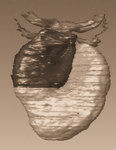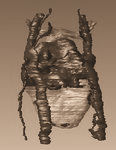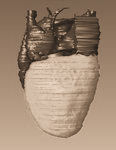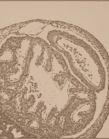Gallery pages for the European Pond Turtle (Emys orbicularis)
Anatomy and development of the Emys orbicularis heart, Yntema Stage 8
This page gives access to a collection of additional pictures (under Pictures in the menu), animation sequences (under Animations in the menu) and interactive browsing using the 3D model browser (under Interactive in the menu) of heart development at stage 8 of Emys orbicularis. The Index in the menu links to the other developmental stages.
Legends:A, atrium; AA, aortic arch; ACV, anterior cardinal vein; AVC, atrioventricular canal; CA, cavum arteriosum; CAVV, cushion tissue forming the atrioventricular valve; CP, cavum pulmonale; CCV, common cardinal vein; CV, cavum ventrale; DC, distal cushions; F, foramen; HS, horizontal septum; HSt, heart stalk; IAS, interatrial septum; IHC, inner heart curve; IVC, intraventricular canal; LAA, left aortic arch; LA, left atrium; LAVC, left atrioventricular canal; MC, mesenchymal cap; OFT, outflow tract; PA, pulmonary artery; PC, proximal cushions; PCV, posterior cardinal vein; PM, pectinate muscle; PV, pulmonary vein; RAA, right aortic arch; RA, right atrium; SV, sinus venosus; TC, trabeculae carneae; V, ventricle; VS, vertical septum; VV, possible venous valve of the superior cardinal vein.
Yntema stage 8.
Cardiac looping has clearly begun at this stage. The caudal end of the original heart tube, now on the dorsal side of the heart, has ended up in a fold, which is forming the atria. In the cranial direction along the tube lie the ventricle and outflow tract, which are still continuous regions. In this part of the tube a distinct bending process is taking place. On leaving the primitive ventricle the tube first passes cranially, then bends caudally and to the left, which forms a first, proximal bend. Subsequently it bends again, cranially and to the left, thereby forming a second, distal bend. The bending is starting to separate the outflow tract and cavum pulmonale from the rest of the ventricle and is responsible for the future development of the horizontal septum (see stage 15). For images follow this link: Developmental stage 8
Animations
the complete model |
the cushion tissue |
Interactive Visualization
For Interactive Visualization and Manipulation of the Yntema Stage 8 model please use our 3D visualizer.
The interactive visualization application is a java applet and it reads the model as produced in TDR-3Dbase from our server. At the server the model is stored in a database which contains the section images, the structure information and the graphical information. The java applet requires Java 3D to be installed on your system and available for the browser. In case you cannot see the the 3D representation tab follow the instructions given below (pdf) or contact your system administrator. The applet is preferably used over a high badwdtih internet connection; the computer should have a good graphics card and sufficient memory.
Instructions for correct use of the 3D browser and software that needs to be installed, click: [PDF]
To start interactive visualization click [HERE]
Index to All Stages
 |
 |
 |
 |